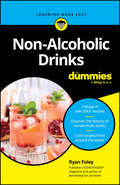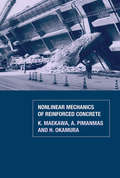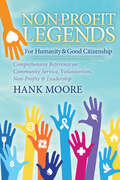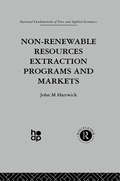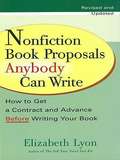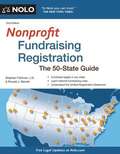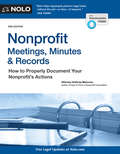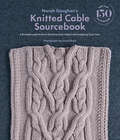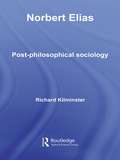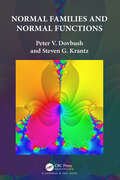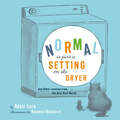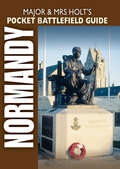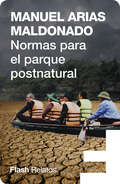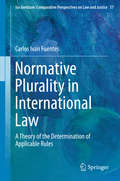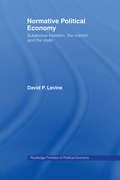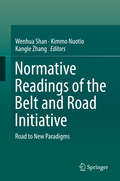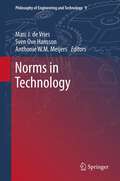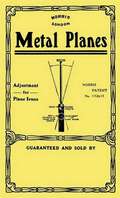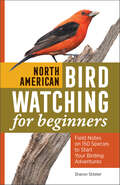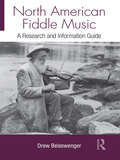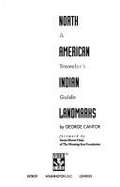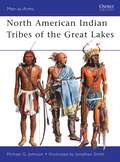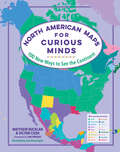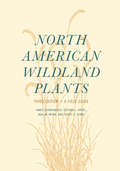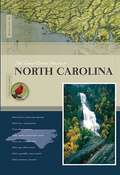- Table View
- List View
Non-Alcoholic Drinks For Dummies
by Ryan FoleyQuench your thirst for zero-proof drinks Non-Alcoholic Drinks For Dummies is full of recipes for non-alcoholic libations. With over 300 recipes for the home mixologist, this book is a great place to start learning how to make and serve tasty and satisfying alcohol-free drinks. You'll learn the history of non-alcoholic drinks, great zero-proof brands to try, and important tools and ingredients you'll need to strengthen your mixing skills. Plus, you'll get a handle on the concepts behind flavor profiles and balanced recipes, so you can start inventing your own alcohol-free creations. When you or your guests are looking to imbibe something classy and ethanol-free, Non-Alcoholic Drinks For Dummies is your go-to. Discover 300+ non-alcoholic cocktail recipes, plus a breakdown of ingredients and flavor profiles Stock up on shakers, mixing tools, glassware, and garnishes to up your mixology game Make fun drinks from around the world, and try recipes from famous bars and bartenders Enjoy all the fun of cocktail mixing, without all the side effects of alcohol With Non-Alcoholic Drinks For Dummies, you and your sober-minded friends and family can skip the soda and seltzer water and instead enjoy fancy beverages full of flavor.
Non-Linear Mechanics of Reinforced Concrete
by K. Maekawa H. Okamura A. PimanmasThis book describes the application of nonlinear static and dynamic analysis for the design, maintenance and seismic strengthening of reinforced concrete structures. The latest structural and RC constitutive modelling techniques are described in detail, with particular attention given to multi-dimensional cracking and damage assessment, and their p
Non-Profit Legends for Humanity & Good Citizenship: Comprehensive Reference on Community Service, Volunteerism, Non-Profits & Leadership
by Hank MooreNon-Profit Legends is a comprehensive overview book on serving communities and motivating leadership for non-profits. Author Hank Moore has worked with and advised hundreds of non-profit organizations, including charities, educational institutions, public sector entities, associations, and corporate citizenship programs. In Non-Profit Legends Hank uses his experience and teaches readers to embrace the past, with direct relationship to the future. Inside you will find extensive information about history, cultural enlightenment and community leadership knowledge, all rolled in one, plus a dynamic panorama of humanitarian contributions to society. Hank Moore is the highest level of business overview expert and is in that rarified circle of visionaries such as Peter Drucker, Stephen Covey and W. Edwards Deming. The Business Tree™ is his trademarked approach to growing, strengthening and evolving business, while mastering change. He advises companies about growth strategies, visioning, planning, leadership, futurism and Big Picture issues. He has written a series of business books. This is the third book in his Legends series, paralleling pop culture, history and innovative strategies. He has won lifetime achievement awards for leadership. Hank Moore’s Legends books embrace history, cultural phenomena and strategies for success.
Non-Renewable Resources Extraction Programs and Markets: Extraction Programs And Markets (Fundamentals Of Pure And Applied Economics Ser. #Vol. 3)
by J. HartwickConsiders the role of economics in discussions about the depletion of finite stocks of natural resources including oil.
Nonfiction Book Proposals Anybody can Write (Revised and Updated)
by Elizabeth LyonSign the contract...then write the book. The good news is that almost every nonfiction book published is sold by a proposal. In this comprehensive yet accessible guide, you will learn exactly what a proposal is, what it must contain, and how to pull yours together into an informative, persuasive selling package. Already a favorite for thousands of aspiring writers, this book has been revised and updated by Elizabeth Lyon to feature nearly two dozen actual proposals, plus: · Choosing a topic based on current trends and competing titles · Drafting the perfect concept statement--daring agents and editors to reject you · Defining and targeting your readership--then connecting with them · Preparing a table of contents and chapter summaries · Submitting exciting and well-written sample chapters · Writing query letters · Devising a marketing plan that will excite agents and publishers ·...
Nonprofit Fundraising Registration
by Stephen FishmanRaise money for your nonprofit without IRS trouble! Your nonprofit needs financial support, which means that you're most likely dependent on the kindness of donors to fill your coffers. If your nonprofit plans to solicit funds from out-of-state donors by phone, letter, email, on the web, or in any other manner, it's essential to fill out IRS Form 990 so that your organization stays legal. Nonprofit Fundraising Registration is your 50-state guide to the complex and varied registration requirements you'll need to meet while fundraising for your nonprofit. Learn how to keep your 501(c)(3) status when you're collecting cash, including: . exemptions from registration . how to register in different states . initial and annual filing requirements . rules for professional fundraisers . other crucial information your organization needs to legally fundraise outside of your home state You can't afford to overlook registration requirements -- use Nonprofit Fundraising Registration, your plain-English guide, to keep your nonprofit status in the eyes of the IRS. Plus, get the background information you need and get a line-by-line tutorial for the Unified Registration Statement, contact information for each state, and instructions on filing requirements for each state.
Nonprofit Meetings, Minutes & Records: How To Run Your Nonprofit Corporation So You Don't Run Into Trouble
by Anthony MancusoNonprofit? Stay out of IRS trouble with the ultimate corporate housekeeping tool! Nearly 1.5 million nonprofit organizations are busy preserving historic sites, saving libraries, helping the homeless, greening our cities--and so much more. Yet, while some have sophisticated record-keeping systems, most nonprofits are staffed by volunteers who need help running the organization and keeping up a proper--and legal--paper trail. Help has arrived! With Nonprofit Meetings, Minutes & Records, you'll get the all-in-one solution every nonprofiteer needs to hold meetings and document actions taken by board members. Step by step, it walks readers through: calling meetings appointing officers taking minutes making resolutions voting on proposals adjourning meetings working with a lawyer, if necessary, and finding a tax adviser. Nonprofit Meetings, Minutes & Records also provides useful tips and advice on how to do important tasks, such as organizing records, preparing meeting folders, and taking minutes. Plus, all necessary legal documents are included for you to fill out. It's everything you need to keep your nonprofit running smoothly and legally.
Norah Gaughan's Knitted Cable Sourcebook: A Breakthrough Guide to Knitting with Cables and Designing Your Own
by Norah GaughanA groundbreaking stitch dictionary from a cable master, featuring 150 cable stitch patterns and fifteen garment patterns to test your skills.This guide for the modern knitter presents more than 150 new and innovative cable stitch patterns ranging from basic to complex and offers enlightening insight into how cables are engineered, how knitters can design their own, and how knitters can mix and match cables in a knitting pattern. Teacher, author, and master knitter Norah Gaughan shares her design principles and offers clear cable-making instruction throughout, always in a conversational, easy-to-understand voice that proceeds naturally, as one cable idea leads to the next. Master the art of cable knitting, then test your newfound skills with the fifteen garment patterns for wraps, sweaters, and accessories.
Norbert Elias: Post-philosophical Sociology
by Richard KilminsterFew sociologists of the first rank have scandalised the academic world to the extent that Elias did. Developed out of the German sociology of knowledge in the 1920s, Elias’s sociology contains a sweeping radicalism which declares an academic ‘war on all your houses’. His sociology of the ‘human condition’ sweeps aside the contemporary focus on ‘modernity’ and rejects most of the paradigms of sociology as one-sided, economistic, teleological, individualistic and/or rationalistic. As sociologists, Elias also asks us to distance ourselves from mainstream psychology, history and above all, philosophy, which is summarily abandoned, although carried forward on a higher level. This enlightening book written by a close friend and pupil of Elias, is the first book to explain the refractory, uncomfortable, side of Elias’s sociological radicalism and to brace us for its implications. It is also the first in-depth analysis of Elias’s last work The Symbol Theory in the light of selected contemporary developments in archaeology, anthropology and evolutionary theory.
Normal Families and Normal Functions
by Steven G. Krantz Peter V. DovbushThis book centers on normal families of holomorphic and meromorphic functions and also normal functions. The authors treat one complex variable, several complex variables, and infinitely many complex variables (i.e., Hilbert space).The theory of normal families is more than 100 years old. It has played a seminal role in the function theory of complex variables. It was used in the first rigorous proof of the Riemann mapping theorem. It is used to study automorphism groups of domains, geometric analysis, and partial differential equations.The theory of normal families led to the idea, in 1957, of normal functions as developed by Lehto and Virtanen. This is the natural class of functions for treating the Lindelof principle. The latter is a key idea in the boundary behavior of holomorphic functions.This book treats normal families, normal functions, the Lindelof principle, and other related ideas. Both the analytic and the geometric approaches to the subject area are offered. The authors include many incisive examples.The book could be used as the text for a graduate research seminar. It would also be useful reading for established researchers and for budding complex analysts.
Normal Is Just a Setting on the Dryer: And Other Lessons from the Real Real World
by Adair LaraWhen the self-help books just aren’t helping, it’s time to call in the experts: real people . . . San Francisco Chronicle columnist Adair Lara polled her readers for life lessons learned through experience, receiving thousands of heartfelt and irreverent responses. The best are compiled here in more than two hundred bits of priceless counsel, accompanied by witty, whimsical illustrations by award-winning artist Roxanna Bikadoroff. This handy little volume is filled with humor, unconventional insights, and the kind of common wisdom that will always bear repeating.
Normandy: Normandy Landing Beaches (Major & Mrs Holt's Pocket Battlefield Guide)
by Tonie Holt Valmai HoltA compact traveler&’s guide to the French region&’s World War II historical sites, featuring planned itineraries of places to see and where to go. This guidebook covers the present-day battlefield and the actions that took place on and immediately behind the D-Day beaches, and Major and Mrs. Holt's Pocket Battlefield Guide to Normandy has been put together to take you around the area. This book is part of a new series of guides designed conveniently in a small size for those who have only limited time to visit, or who are simply interested in as an introduction to the historic battlefields, whether on the ground or from an armchair. They contain selections from the Holts&’ more detailed guide of the most popular and accessible sites plus handy tourist information, capturing the essential features of the Battles. The book contains many full color maps and photographs and detailed instructions on what to see and where to visit.
Normas para el parque posnatural
by Manuel Arias MaldonadoUna reflexión sobre la relación entre la sociedad y la naturaleza en el contexto del cambio climático. En este ensayo, Manuel Arias Maldonado reflexiona sobre implicaciones filosóficas y morales relacionadas con el cambio climático. ¿Podemos conseguir frenarlo sin alterar los límites de las libertades individuales? ¿Es posible volver al período anterior al Antropoceno? ¿Hasta qué punto son compatibles los principios para preservar la naturaleza con las sociedades liberales? A través de estas preguntas, el autor plantea la necesidad de problematizar conceptos como democracia o esfera privada, con tal de garantizar la supervivencia de la especie. Ya que, tal como él mismo afirma, «cuidar del entorno natural es cuidar de la libertad de los ciudadanos del futuro.»
Normative Plurality in International Law
by Carlos Iván FuentesThis book provides a theoretical framework for explaining the choices made by international decision-makers in terms of what constitutes law. It comprehensively analyzes the practice of human rights courts in applying legal instruments outside their competence and proposes that this practice recognizes that different normative instruments coexist in an un-ordered space, and that meaning can be produced by the free interaction of those instruments around a problem. Based on this, the book advances its normative plurality hypothesis, which states that decision-makers must survey the acquis of international law in order to identify all the instruments containing relevant normative information for a particular situation. The set of rules of law applicable to the situation must then be complemented with other instruments containing specific normative information relevant to the situation, resulting in a complete system of norms advancing a common purpose.
Normative Political Economy: Subjective Freedom, the Market and the State (Routledge Frontiers Of Political Economy Ser.)
by David P. LevineNormative Political Economy explores the criteria we use for judging economic institutions and economic policy. It argues that prevailing criteria lack sufficient depth in their understanding of subjective experience. David Levine's arguments cover topics which include: * basic needs, equality and justice * freedom, self-integration and creative living * the role of the state * capitalism and the good society
Normative Readings of the Belt and Road Initiative: Road To New Paradigms
by Wenhua Shan Kimmo Nuotio Kangle ZhangThis timely book offers revealing insights into the changing role of China in world governance as exemplified by the Silk Road Initiative, the People’s Republic’s first published major initiative for external affairs. Focusing on various aspects of the Silk Road Initiative, particularly those that are largely neglected in current discussions, including culture and philosophy, finance and investment, environmental protection and social responsibility, judiciary and lawyers, the authors explore a wide range of contexts in which China’s role as an emerging power in international relations and international law is examined. In the current era of ever-increasing populism, protectionism and challenges to globalization, the authors explore the Chinese philosophy underpinning Chinese norms of regional and international development. Bearing in mind the political and economic uncertainties hampering the establishment of such norms, the authors offer crucial insights into how the Silk Road Initiative could or should be developed and regulated.Given its depth of coverage, the book is an indispensable read for anyone interested in the Initiative and its social-legal implications.
Norms in Technology
by Sven Ove Hansson Anthonie W.M. Meijers Marc J VriesThis book is a distinctive fusion of philosophy and technology, delineating the normative landscape that informs today's technologies and tomorrow's inventions. The authors examine what we deem to be the internal norms that govern our ever-expanding technical universe. Recognizing that developments in technology and engineering literally create our human future, transforming existing knowledge into tomorrow's tools and infrastructure, they chart the normative criteria we use to evaluate novel technological artifacts: how, for example, do we judge a 'good' from a 'bad' expert system or nuclear power plant? As well as these 'functional' norms, and the norms that guide technological knowledge and reasoning, the book examines commonly agreed benchmarks in safety and risk reduction, which play a pivotal role in engineering practice. Informed by the core insight that, in technology and engineering, factual knowledge relating, for example, to the properties of materials or the load-bearing characteristics of differing construction designs is not enough, this analysis follows the often unseen foundations upon which technologies rest--the norms that guide the creative forces shaping the technical landscape to come. The book, a comprehensive survey of these emerging topics in the philosophy of technology, clarifies the role these norms (epistemological, functional, and risk-assessing) play in technological innovation, and the consequences they have for our understanding of technological knowledge.
Norris Metal Planes
by Joel MoskowitzThis catalog, a reprint of the two most important Thomas Norris catalogs, represents almost the full line of Norris planes up through the end of the 1920's. The 1914 catalog introduced the patented adjuster feature. Illustrations in the later catalog, from around the mid-1920 s, were redone to show off the adjuster feature. The Norris section from the 1938 catalog of the famous London tool merchant Buck & Ryan is also included here. As a bonus, four pages of new color photographs of a number of these highly sought-after planes from the collection of the Museum of Woodworking Tools have been added. This is an essential catalog for anyone interested in acquiring a Norris, or just interested in the company's style of tools and place in hand tool history.
North American Bird Watching for Beginners: Field Notes on 150 Species to Start Your Birding Adventures
by Sharon StitelerLearn how to identify 150 North American birds—your new summer hobbyFrom the tiny ruby-throated hummingbird to the powerful bald eagle, there's a fascinating variety of unique and beautiful birds that call North America home. This compact field guide is the perfect introduction to birding. You'll find essential information about 150 North American species and expert advice on how to get started on your bird-watching journey.Dive into the perfect summer activity with:The basics of bird watching—Learn important birding terminology, what equipment to have on hand, and how to log and submit your bird sightings.Complete bird profiles—Discover full-color photos and need-to-know details about each species' appearance, behavior, and population range.Easy-to-find information—This book's simple organization makes it the ideal companion for your bird watching adventures, with clearly marked sections for common backyard birds, songbirds, shorebirds and waterbirds, and raptors.Get to know your feathered neighbors this summer with this field guide to the birds of North America.
North American Fiddle Music: A Research and Information Guide (Routledge Music Bibliographies)
by Drew BeisswengerNorth American Fiddle Music: A Research and Information Guide is the first large-scale annotated bibliography and research guide on the fiddle traditions of the United States and Canada. These countries, both of which have large immigrant populations as well as Native populations, have maintained fiddle traditions that, while sometimes faithful to old-world or Native styles, often feature blended elements from various traditions. Therefore, researchers of the fiddle traditions in these two countries can not only explore elements of fiddling practices drawn from various regions of the world, but also look at how different fiddle traditions can interact and change. In addition to including short essays and listings of resources about the full range of fiddle traditions in those two countries, it also discusses selected resources about fiddle traditions in other countries that have influenced the traditions in the United States and Canada.
North American Indian Landmarks: A Traveler's Guide
by George CantorIdentifies some 300 sites, gives some history about each, and provides phone numbers and admission data (hours, cost). Arrangement is by region. Supplementary material includes a chronology, a short glossary, and a list of books for further reading. Annotation c. by Book News, Inc., Portland, Or.
North American Indian Tribes of the Great Lakes
by Michael Johnson Jonathan SmithThe Great Lakes were the main arena for the fur trade in colonial North America, which drew European explorers and trappers deep into the northern USA and Canada from the 17th century onwards. The desire to control the supply of this luxury item sparked wars between Britain and France, as well as conflicts between rival tribes and the newly formed United States of America, which continued until 1840. The main tribes of the area were the Huron, Dakota, Sauk and Fox, Miami and Shawnee. All were drawn into the conflicts throughout the Great Lakes region during the French-Indian War (1754-1763), as well as the American Revolution. These conflicts culminated in Black Hawk's War of 1832, as Native American tribes attempted to resist the loss of their lands to white settlers in what is now Illinois, Iowa and Wisconsin. The defeat of these tribes forever altered the climate of the central American states. This new addition to Osprey's coverage of Native American tribes details the growth of the fur trade in the Great Lakes area, the various skirmishes, battles and wars that were fought to control this vital trade and important trade area. With specially-commissioned plates, as well as photographs of locations and/or artifacts where available, expert author Michael Johnson also details the lives and material culture - including clothing, equipment and weaponry - of the local tribes themselves before their circumstances were irrevocably altered.
North American Maps for Curious Minds: 100 New Ways To See The Continent (Maps for Curious Minds #0)
by Matthew Bucklan Victor CizekThe Maps for Curious Minds series is back—with 100 vivid infographic maps that transform the way we understand the cultural and geographical wonders of North America No matter how well you think you know North America, the 100 infographic maps in this singular atlas uncover a trove of fresh wonders that make the continent seem like the center of the universe. Did you know that North America is where the first T. rex was found? Or that it’s where you can visit the world’s biggest geode as well as its oldest, tallest, and largest trees—not to mention the world’s tallest and steepest roller coasters?! Brimming with fascinating insight (Who is the highest-paid public employee in each state?) and whimsical discovery (Where can you visit the world’s largest island in a lake on an island in a lake on an island?), this book highlights the unexpected contours of geography, history, nature, politics, and culture, revealing new ways to see North America—and the hundreds of millions who call it home.
North American Wildland Plants, Third Edition: A Field Guide
by James Stubbendieck Stephan L. Hatch Neal M. Bryan Cheryl D. DunnNorth American Wildland Plants contains descriptions of the salient characteristics of the most important wildland plants of North America. This comprehensive reference assists individuals with limited botanical knowledge as well as natural resource professionals in identifying wildland plants. The two hundred species of wildland plants in this book were selected because of their abundance, desirability, or poisonous properties. Each illustration has been enhanced with labels pointing to key characteristics to facilitate the identification of unknown plants. Each plant description includes plant characteristics, an illustration of the plant with enlarged parts, and a general distribution map for North America. Each species description includes nomenclature; life span; origin; season of growth; inflorescence, flower or spikelet, or other reproductive parts; vegetative parts; and growth characteristics. Brief notes are included on habitat; livestock losses; and historic, food, and medicinal uses. This third edition contains additional refinements in the nomenclature, distribution, illustrations, and descriptions of plants.
North Carolina
by Teresa WimmerIntroduction to the state of North Carolina, including its early history, its land and resources, some of its famous people, and unique events.
